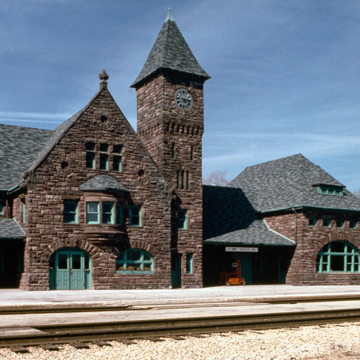You are here
Niles Amtrak Station (Niles Station of the Michigan Central Railroad)
This fine Richardsonian Romanesque station still serves as the last major stop on the old Michigan Central Railroad line (now Conrail) between Detroit and Chicago. It replaced a passenger station that the railroad built as a temporary shelter in 1873, which had in turn replaced an earlier station that had burned, but which served for eighteen years. The Niles depot was intended as the showpiece of the Michigan Central, and it was completed in time to impress travelers to the 1893 Chicago World's Columbian Exposition. German-born architects Frederick H. Spier and William C. Rohns (1856–1951), whose association in Detroit between 1884 and 1913 resulted in designs for all of the principal depots on the Michigan Central and Grand Trunk Western Railroad lines, drafted plans for the Niles station. J. D. Hawks, chief engineer for the Michigan Central, and his assistant, C. W. Hotchkiss, supervised the construction.
The rock-faced Carroll, Ohio, brown sandstone station is massed in three sections under a substantial hipped and gabled roof. A square, pyramid-roofed stair tower rises to a height of sixty-eight feet on the south and is punctuated by an illuminated clock face that is five feet in diameter. Round-arched entrances give access and light to the interior, and broad overhangs and shed roofs shelter passengers. The semicircular apse-like west section holds waiting rooms and the ticket office; the central section, the kitchen and the dining room; and the eastern section, baggage storage. Above the main floor are offices and apartments.
To beautify the surroundings, John Gipner constructed an elaborate park, with gardens, fountains, and greenhouses like those that Frederick Law Olmsted created for H. H. Richardson's depots on the Boston and Albany Railroad. This gave to Niles the nickname the “Garden City.” Today, the gardens are gone, but Amtrak has restored the station.
Writing Credits
If SAH Archipedia has been useful to you, please consider supporting it.
SAH Archipedia tells the story of the United States through its buildings, landscapes, and cities. This freely available resource empowers the public with authoritative knowledge that deepens their understanding and appreciation of the built environment. But the Society of Architectural Historians, which created SAH Archipedia with University of Virginia Press, needs your support to maintain the high-caliber research, writing, photography, cartography, editing, design, and programming that make SAH Archipedia a trusted online resource available to all who value the history of place, heritage tourism, and learning.


